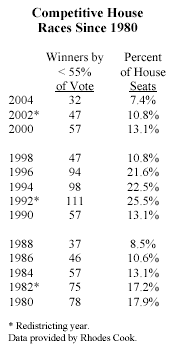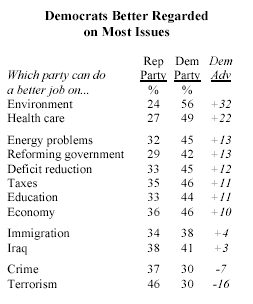by Andrew Kohut
At the start of this midterm election year, two heavyweight political trends are poised for a head-on collision.
One is fueled by the low standing in the polls that the president and his party currently register, a position that invariably spells trouble for the “in party” in congressional elections. The other is driven by the sharp rise in the number of U.S. House seats that have become uncompetitive as a result of incumbent-protection gerrymandering – a development that raises some doubt that even a strong national vote for change would yield much of a partisan shakeup in Congress.
And there’s a third factor at play as well – some analysts contend that the Democrats are the gang that can’t shoot straight, destined to blow their big opportunity in 2006.

Gerrymandering and population shifts may indeed make big swings in congressional seats less likely – but not out of the question. According to political analyst Rhodes Cook, the number of competitive races for House seats has dwindled in recent years from a high of 111 competitive races in 1992 to a low of 32 in 2004. While 32 sounds like an ominously small number, it is not that much smaller than the mere 37 races that were up for grabs in 1988. Two years later the number of competitive races swelled to 57, by Cook’s calculations, and in 1992 it jumped again to its recent high of 111.
History suggests that the current climate of public opinion about the Bush presidency, should it persist through this election year, might “nationalize” the House elections in a way that would likely overwhelm at least some of these new local fortifications. And, of course, incumbent-protection gerrymandering is not a factor in the U.S. Senate, where the election boundaries are static.
Current polling data point to a desire for change almost as strong as the one that began building late in 1993 – one year before the historic 1994 election, which gave Republicans control of Congress for the first time in 40 years. This year, with just 34% of the public expressing satisfaction with national conditions, the president’s approval rating hovers around the 40% mark in most national surveys.
This discontent is rubbing off on both the Republican Party generally and on the GOP-controlled Congress. A February Pew survey found the Republican Party’s favorable rating slumping to 44% from 52% a year ago, And a January Gallup Poll found 67% of the public disapproved of the way Congress is handling its duties compared with 48% a year earlier. Again, we have to go back to the mid 1990’s to match that level of discontent.
The confluence of these two sentiments is also evident in a November Gallup poll. It found a 46%-to-34% plurality saying the country would be better off if Democrats rather than Republicans controlled Congress. In turn, most questions about voting intentions show a significant edge for the Democrats. Pew’s February survey finds 50% of registered voters inclined to vote for a Democratic candidate for the House versus 41% for a Republican. Four years ago at this time voting intentions were evenly divided 45% Democratic to 46% Republican.Another important difference: Back then, a plurality of voters said they would be casting a vote for – not against – President Bush in the coming midterm elections. Today, by a margin of 31% to 18%, voters tell Pew that if the fall elections were being held today, they would think of their congressional choice as a vote against him.
Without exception in modern times, presidents whose approval ratings tumble end up costing their party seats in the midterm elections. President Eisenhower’s rating had fallen from 73% at the start of his second term to 57% in October 1958. (Levels of discontent were far more modest in those days.) Republicans lost 48 seats that year. In 1974, in the aftermath of Watergate, the GOP also lost 48 seats. And of course, in 1994, Clinton’s approval rating having sunk to 41%, the Democrats gave up 53 seats and control of Congress.

By contrast, when presidents are doing particularly well with the public, their parties do relatively well in the midterms. Take the case of Clinton four years later in 1998:Though facing impeachment he had the public with him. With his approval score at 65%, the Democrats gained 5 seats. Similarly, the Republicans gained 6 seats in 2002 owing to Bush’s strong 61% approval rating that year.
Whenever off-year elections become nationalized, they are primarily judgments about the performance of the party in power. And here there is considerable good news for the Democrats: on their ability to handle a broad array of policy issues, they are better regarded than the GOP.
Pew’s February survey found voters thinking that Democrats could do a better job of handling 10 of 12 issues covered in the survey. Democrats enjoyed a huge advantage in ability to handle the environment and health care, and a moderate advantage on energy, reforming government, deficit reduction, taxes, education, and the economy. The GOP was seen as more competent on just two issues: crime and terrorism.
Such a potentially powerful national partisan tide can also directly erode the most important advantage in Congressional politics – incumbency. At this point, there are some signs that discontent with Congress may be affecting incumbents. The NBC/Wall Street Journal polls taken in 2005 found fewer voters saying that that their own representative deserves reelection than had been the case in surveys conducted since 1994. Pew’s latest poll also shows somewhat more of an anti-incumbent mood than in 2002, 1998 or 1990.
Nonetheless the Republicans have one significant life line in a sea of discontent about President Bush and national conditions generally: failure of the Democrats’ leadership to distinguish itself. Despite a lack of confidence in the GOP’s ability to handle most issues, the party is given an edge in the Washington Post/ABC poll for having stronger leaders, and in the Pew survey for having better leaders. And a Pew survey last month found that while just 33% approved of Republican congressional leaders, only 34% approved of the way Democratic leaders were doing their job.
So with nine months to go until the midterms, we see the public’s strong discontent with the powers-that-be in Washington, usually a harbinger of political change, contending with the forces of safe-seat redistricting and low public regard for Democratic leaders. How these factors play out are the big political unknowns of 2006.
One indicator you may want to keep an eye on if you’re tracking the odds over the course of the year: responses to the Congressional voting intentions questions asked in various polls. These measures are taken regularly by Pew, Gallup and others and they have a very good record in midterms for predicting the popular vote for the House. They are also a good indicator of the climate of opinion that will affect Senate races as well.
The stakes are high. If Democrats were to pick up 16 seats in the House or six in the Senate, those chambers would switch from Republican to Democratic control; such a change would undermine Bush’s legislative agenda during the final two years of his presidency. That number of seat switches is not particularly high by historic standards – certainly not when an “in party” is looking at the kind of polling numbers that the GOP has right now. The big question for 2006 is: Is history still relevant?